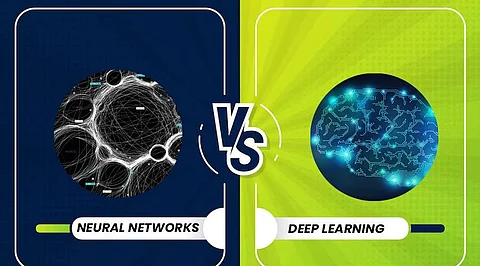

Since their inception in the late 1950s, Artificial Intelligence and machine learning have come a long way. These technologies are now extremely advanced and sophisticated. However, even though technological advancements in the field of data science are to be commended, they have produced a slew of jargon that is beyond the comprehension of the average person.
Neural Networks vs. Deep Learning While Deep Learning incorporates neural networks into its architecture, there is a significant distinction between the two. In this section, we will clarify the primary distinctions between neural networks and deep learning.
Neural Networks: Artificial neurons form the core computational unit of this structure, which is made up of machine learning (ML) algorithms and focuses on discovering the underlying patterns or connections within a dataset, just like the human brain does when making decisions.
Deep Learning: It is a subfield of machine learning that uses multiple layers of multiple nonlinear processing units to transform and extract features. The machine learning process is carried out by several layers of artificial neural networks. The information is sent to the second layer of the neural network after the raw data input is processed by the first layer.
After that, the information is processed further by the second layer, which sends it to the next layer along with additional information like the IP address of the user. This procedure continues at every level of the Deep Learning network until the desired outcome is reached.
The parts of a neural network are as follows:
Neurons: A mathematical function called a "neuron" is made to behave like a biological neuron. It registers the weighted normal of the information info and goes the data through a nonlinear capability, a.k.a. The activation function (such as the sigmoid, for instance).
Connection and Weights: As the name proposes, associations associate a neuron in one layer with one more neuron in a similar layer or another layer. There is a weight value attached to each connection. A weight here indicates how strong the connection between the units is. The goal is to lower the weight value to make it harder to lose weight (an error).
Propagation Function: A neural network uses two propagation functions: backward propagation which results in the "error value," and forward propagation which results in the "predicted value."
Rate of Learning: Gradient Descent is used in neural network training to get the weights right. At each iteration, back-propagation is used to deduct the weight from the derivative of the loss function for each weight value. The learning rate determines how quickly or slowly the model's weight (parameter) values should be updated.
A Deep Learning model comprises the accompanying parts:
Motherboard: Typically, the model's motherboard chipset is based on PCI-e lanes.
Processors: The GPU expected for Profound Learning is not entirely settled by the number of centers and cost of the processor.
RAM: This is the actual storage and memory. The RAM must be huge because Deep Learning algorithms use more CPU and storage space.
PSU: Employing a large PSU that is capable of handling massive and complex Deep Learning functions becomes critical as the amount of memory required increases.
Learn machine learning online from the best universities in the world. Accelerate your career by completing a Master, Executive PGP, or Advanced Certificate Program.
For the most part, it requires less investment to prepare brain organizations. Their accuracy is lower than that of deep learning methods. The training of deep learning models takes more time. Their accuracy is higher than that of neural networks. This is the main difference between neural networks and deep learning.
Theoretical issues, training issues, hardware issues, hybrid techniques, and examples of criticism from the real world all play a role in neural network criticism. On the other hand, criticism of deep learning is based on mistakes, theories, cyber threats, and other things. This distinction between deep learning and neural networks lets you know which model to use for the problem.
The deep learning network more accurately interprets your tasks than the neural network does.
The applications are the most significant point of comparison between neural networks and deep learning.
System identification
Management of natural resources
Control of processes
Control of vehicles
Quantum chemistry
Making decisions
Playing games
Recognizing patterns
Identifying faces
Classifying signals
Recognizing sequences
Data mining
Machine translation
Filtering email spam
Filtering social networks, etc.
Image recognition
automatic speech recognition
natural language processing
visual art processing
drug discovery and toxicology
customer relationship management
mobile advertising
recommendation engines
bioinformatics
image restoration
Join our WhatsApp Channel to get the latest news, exclusives and videos on WhatsApp
_____________
Disclaimer: Analytics Insight does not provide financial advice or guidance. Also note that the cryptocurrencies mentioned/listed on the website could potentially be scams, i.e. designed to induce you to invest financial resources that may be lost forever and not be recoverable once investments are made. You are responsible for conducting your own research (DYOR) before making any investments. Read more here.
